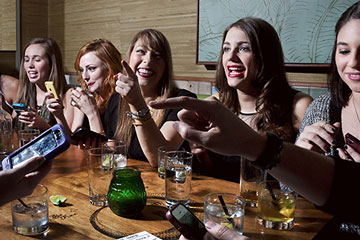
A group of girlfriends gathers at Babys All Right, a Brooklyn bar, to play a Tinder drinking game.
The first time I swiped, I was sardined between friends on a train back to New York City. With an hour to go and conversation running dry, we decided to download a smartphone app we kept seeing people use during our weekend away: Tinder. Suddenly the screen of my phone was inundated with an ever updating stream of male suitors: loafer-wearing Kip, 28, popping champagne on the deck of a boat (pretentious--swipe left!); shirtless Aaron, 31, winking at his reflection (bathroom-mirror selfie--swipe left!). My fingers were moving so quickly, I almost mistakenly swiped left for tall, dimpled Peter, 30, smiling from a mountaintop (swipe right!). I soon experienced my first Tinder high--the endorphin rush of a match. Somewhere "5 miles away," Peter liked me too. I was hooked.
Tinder is a 17-month-old location-based dating app that boils romance down to the basics: users specify their preferred range of age and proximity and are shown corresponding photographs of nearby potential mates along with cursory information imported from Facebook. Users can swipe right for "like" or left for "nope." When two people swipe right for each other and produce a match, they get the option to "send message" or "keep playing."
Tinder is one of a host of new mobile dating apps based on a system of snap judgments that function kind of like a game. At 26, I'm smack in the middle of the demographic these companies are trying to woo. We've been dubbed the hookup generation, ambitious multitaskers who commit reluctantly and are obsessed with digital distractions. This is both true and an oversimplification. These apps play to stereotypes while simultaneously perpetuating them. Because even if we typically marry three to four years later than Gen Xers, we still (eventually) want love, and it's too soon to know if this crop of dating apps will make finding it easier or leave us trapped in a new kind of flirting limbo.
Old Game, New Rules
Dating has always been something of a game, but it's now built into a device we carry and check some 150 times a day. Traditional dating sites like eHarmony and Match.com were designed to narrow down an endless stream of potential matches to that one right fit--the presumed goal being the user's exit from the game. But many of the new apps aimed at a younger audience revel in the wide stream. Their creators have developed addictive interfaces designed to keep their user base constantly stimulated, engaged and plugged in. Profiles are simple to set up and just as easy to dismiss. It's like Grand Theft Auto for your hormones.
Tinder even takes its visual cues from a classic game: the stack of dating-profile photos displayed in the app was modeled after a deck of cards. "When you have a deck or a pile of cards," says Sean Rad, co-founder of the Los Angeles--based company, "the natural urge is to interact with it." The swiping motion that helps make Tinder addictive was already popular in mobile games like Candy Crush, which users "play without thinking much about any one move," according to Sebastian Knutsson, Candy Crush's chief creative officer. "That's also what Tinder provides." Mindlessly swiping through hundreds of pictures is a habit that's hard to break, whether it's candy icons or people.
